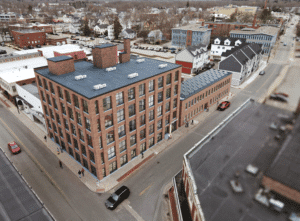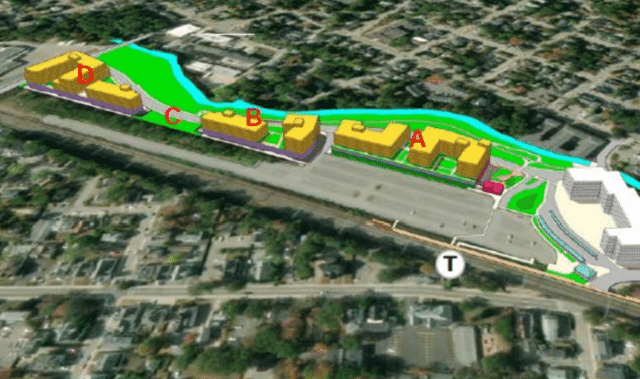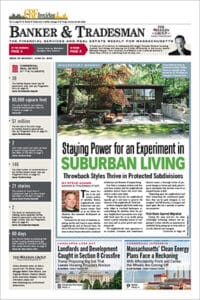
Developers are tapping into Gateway Cities public financing programs to create housing in downtown Attleboro such as Lee Properties’ The Jewel. Photo courtesy of Lee Properties
Even with the post-pandemic surge in remote work, there is an appetite for transit-oriented development along the MBTA commuter rail line connecting to Boston and Providence.
Attleboro officials, in partnership with the transit agency, are laying the groundwork to bring more than 600 new units of housing to the city’s downtown near the MBTA’s Attleboro station. The chosen master developer will implement the vision to bring forward a variety of market-rate and affordable housing units to the city of 46,000 hugging the Rhode Island border.
Developers and officials see opportunity in Attleboro, as it presents a more affordable housing option for those who want to live closer to Boston and Providence. But there are still some standard development headaches that apply here, even if it costs less to develop in Attleboro than larger urban centers.
“We’re seeing folks moving to Attleboro who before would have lived, frankly, inside of the I-495 loop but now can’t afford it,” Attleboro Mayor Cathleen DeSimone said. “It’s a really interesting time.”
Responses are due Aug. 14 for the city and MBTA’s request for qualifications to develop a 6.5-acre site next to the Attleboro station. The Attleboro Redevelopment Authority is seeking developers that are experienced in transit-oriented developments to lead a project delivering at least 610 housing units.
The Attleboro station schedule delivers passengers to Boston’s South Station in approximately 50 minutes and Providence in 20 minutes. Six Boston-bound trains and two Providence-bound trains serve the station during the morning rush hour, plus six more trains that depart Boston and three that depart Providence during the evening commute window, along with a scattering of other trains during the day.
Housing Production Hoped to Curb Price
Attleboro’s TOD push comes amid the scramble to comply with the Massachusetts law requiring greater housing density in MBTA communities with transit stations or close to MBTA service.
DeSimone sees the measure and ongoing multifamily housing development in downtown Attleboro as a way to usher in new economic opportunities for the Gateway City, as well as keep things affordable for longtime residents.
While median rent prices – at $2,000 per month – in Attleboro are down 14 percent in the last month, they are still up 16 percent from only a year ago, according to data from Zumper. The city’s year-to-date median home sale price – at $510,000 – is up more than 9 percent from a year ago, according to The Warren Group, publisher of Banker & Tradesman.
“I think this is a major reason behind the MBTA communities push and why you see so many communities moving towards a transformative model,” said Chris McDermott, Attleboro’s economic development director. “We do need to see an increase in housing, as there are these incredibly high rents across the commonwealth.”

A suggested conceptual development plan proposes more than 600 housing units totaling over 600,000 square feet steps from the MBTA’s Attleboro commuter rail station. Image courtesy of Attleboro Redevelopment Authority
Downtown Gains Momentum
While the city navigates the request for qualifications and proposals process for its 600-unit vision near the commuter rail station, Attleboro has seen a wave of new housing projects and proposals in recent years to fuel multifamily momentum.
In recent years, developers added more than 200 units of housing downtown, according to the Attleboro TOD request for qualifications document.
The housing ranged from townhomes to an adaptive reuse project at 37 Union Mills as well as the more than 130 market-rate-unit One Wall Street within the city’s Transit-Oriented Development District. Another adaptive reuse project, Lee Properties’ 45-unit, market-rate The Jewel, is slated to officially open in September.
“A lot of the other Gateway Cities in Massachusetts had already received quite a bit of help and development,” said Jonathan Lee Cozzens, president and CEO of Lee Properties. “We thought that Attleboro would be a great city to start with.”
But Attleboro’s overlooked-until-recently opportunity doesn’t mean developers there are immune from construction challenges found in costlier-to-build markets like Boston.
It costs between $450,000 and more than $500,000 per unit to develop a multifamily project in Attleboro, Cozzens said. That points to incentives for Gateway Cities such as the state’s Housing Development Incentive Program, which provides tax exemptions and tax credits for qualified projects, and historic tax credits are crucial to making a project like The Jewel pencil.
“Unfortunately, there’s no way to build in Greater Boston today unless you’re in an extremely high-income city with a very high [area median income],” Cozzens said. “There’s really no way to get the job done without subsidies like this [HDIP] program.”
Subsidies and incentives fueling multifamily interest may be worth it, however. Leaders point to the housing momentum as going together with downtown revitalization. Downtown storefront vacancies declined from nearly 40 percent to roughly 20 percent since 2019 – an impressive feat considering the pandemic wasn’t kind to brick-and-mortar retail.
Given the growing pipeline in Attleboro – projects at 135 County St. and 34 Wall St. as well as the Briggs Crossing market-rate apartment project are in various stages of planning and development – DeSimone said she didn’t see signs there was any need to add further incentives beyond the existing mix of Gateway Cities offerings and historic tax credits.
“What I’m trying to do is what’s in the city’s best interest, both currently and in the long term: growth by housing [and] growth by adding residents, which will then hopefully lead to more business and economic opportunity,” DeSimone said. “I’m excited to have these opportunities to finally get Attleboro a little closer to what it actually can be.”







